

Teams are exploring differing sidepod solutions as they work towards nailing down their 2023 Formula 1 car designs.
Three different approaches have been employed on the grid this season, with a mix of ‘upwash’, ‘downwash’, and ‘zeropod’ solutions in evidence.
Mercedes has the most radical of those with its zeropod concept, an extremely slimline design that Williams also initially adopted.
Red Bull has a downwash solution, a trend which has been adopted by Aston Martin and more latterly Williams following its mid-season upgrades. Ferrari has gone a different route, a route followed by Haas.
“I’m not sure it’s a choice of best or worst concept, I think it’s just one part of the puzzle,” said Pierre Wache, Red Bull’s Technical Director.
“For sure, if you develop your car around a certain concept, if you change, if will be difficult to find the benefit of it.
“I think you have to be very open-minded on how you see the car and the concept of the car for the future.”
One consideration for sidepod design this year has been the support that the bodywork can offer the floor to prevent unwanted flexing.
That has seen stays used in places, especially at Mercedes, though changes for next year are set to see tweaks made to the floor rules which could impact sidepod design.
“The rules do change for next year, that’s going to change how people are looking at developing their car,” admitted Andrew Shovlin, Mercedes’ Trackside Engineering Director.
“You’d always say that the fastest car is the one that’s got the best concept, so today that’s going to be Red Bull.
“Where that goes into next year is difficult to say, and I don’t think – certainly we as a team have not fixed what our car is going to look like.
“We’re still exploring different concepts, and that process will go on for some time.
“We’re just looking for what will give us the best development opportunity in those new regulations going forward.”
Sidepod design works in conjunction with the floor and rear wing, to channel airflow based on a team’s philosophy.
In Williams’ case, that has been changed mid-season after it introduced an upgrade package to Alex Albon’s car for the British Grand Prix.
That saw Red Bull-esque sculptured sidepods as its most visible change over the launch-spec car with its more zeropod concept.
Aston Martin too changed tack, introducing a markedly different AMR22 for the Spanish Grand Prix – which quickly picked up the ‘Green Red Bull’ tag.
“Through the development phase, we sort of went two different routes; we actually designed the chassis to take two different radiator installations,” said Tom McCullough, Performance Director for Aston Martin.
“When the season started, we elected to go back to an earlier development route that we’d made, more akin to the Red Bull at the moment.
“Regulations are changing next year,” he added.
“We’ve learned so much during this year, but from a cost cap side of things, there’s only so much you can actually do in a season.
“So now’s the opportunity over the winter to decide, with your simulation tools – obviously aerodynamically that’s largely CFD and in the wind tunnel – but what is the right way to go to get the most performance on the car?
“That’s a process which is ongoing at the moment.”
Wache added that, while the Red Bull solution appears the pick of the bunch, that does not mean that all nine teams will end up with the same design.
“I’m not sure that everybody will converge to one; it’s more how you see the new rules, how you try to sort out, and what you try to achieve with a concept.
“It’s one part,” he continued.
“Then, how you make the floor on the car with the sidepods just, after a certain level, try to fix or try to direct the flow.”
Next year’s rule changes see the floor edges raised by 10mm and the throat of the diffuser lifted in an effort to reduce the propensity of cars to porpoise.
That was done on safety grounds following comments from some drivers regarding the repeated impacts of the car on the ground, and the effects it might have on their long-term health.





















Discussion about this post